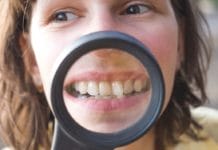How often do we hear, “Just take my teeth out and give me dentures because my parents had them,” from dental patients? Or, “I’m prone to cavities because I was born with soft teeth” as they drink soda and brush once a day?
“Prone” is thrown haphazardly around since everyone is prone to something. Prone is having the natural inclination or tendency to do something. People who have certain genes are prone to oral health conditions, but they shouldn’t feel doomed or defeated. Dental patients’ choices play a significant component in their overall health as well as oral health.
Genes are the individual DNA makeup, hereditary is shared, and lifestyle is a choice. All three play a role in health.
Genes
Chromosomes are the main component of genes and are stored in the nucleus. There are 46 chromosomes with 22 paired and two sex ones. These chromosomes contain up to 25,000 genes. There are two copies per chromosome, one from each parent. Genes are the basic physical unit of hereditary and are the linear sequence of nucleotides along a segment of DNA. They have a specific sequence, and when a gene is changed or disrupted, it can lead to a range of conditions. Ninety-nine percent of our genes are the same within humans. That other one percent is what makes us different from each other.1
Genetics vs. Hereditary
These terms are used interchangeably yet have slightly different meanings. Characteristics are received through genes from our DNA. Passing this information onto the offspring is hereditary.
Genetic diseases occur from an abnormality of the individuals’ genes and may be passed on or not and will always have a mutational change in the genome. Hereditary conditions are from a mutation of a gene and carried from one generation to another.2
Hereditary is passing naturally from parent to offspring through genes. The genetics of eye color, blood type, and health conditions can be inherited. Lifestyle habits can also be hereditary. If the parents lack home care or have a sugary diet, it can also be passed on to the children.
Genetics is the study of gene structure and the inheritance of traits from parent to offspring.
Genetic conditions can happen by:
- A spontaneous gene change in the development of the egg or sperm or at conception
- A gene change passed from parent to child to cause health issues at birth or later in life
- A gene change passed from parent to child that causes a genetic susceptibility to a condition
Having a genetic susceptibility only means you’re at a higher risk of developing a condition; it doesn’t mean you’ll have it. Genetic tooth defects can show as abnormal tooth structures causing multiple dental anomalies.1 If the anomaly is genetic, it will affect multiple teeth if it is an exogenous contribution, and it affects the teeth at the time of development.
Genetic syndromes which cause dental anomalies include:
- Down’s syndrome ‒ Is a trisomy of chromosome 21. It is associated with missing third molars, delayed eruption of permanent teeth, hypocalcification, and hypoplastic defects.
- X-linked syndrome ‒ Associated with anodontia, including reduced alveolar bone and abnormal teeth morphology ‒ peg-shaped or conical.
- Cleidocranial syndrome ‒ Gene RUNX2 affects the development of the teeth and bones.
- Apert syndrome ‒ Associated with an anterior open bite, malocclusion, crowding, and delayed tooth eruption.
- Mohr syndrome ‒ Mutation of the TIMM8A gene. It is associated with cleft palate or lip, small or noduled tongue, hyperplastic frenulum, and notching of the upper lip.
- Tricho-dento-osseous syndrome ‒ Systemic genetic disorder associated with poorly formed enamel and unusual thickness of the jaw.
- Klinefelter syndrome ‒ Genetic condition that occurs in males with an extra X chromosome and is associated with cleft palate, missing premolars, and delayed development of permanent tooth germs.
Some dental genetic anomalies include:
- Amelogenesis imperfecta ‒ Defect is within the genes encoding enamel matrix proteins that regulate enamel. Causes defective or missing enamel.
- Dentinogenesis imperfecta ‒ Discolored teeth or a translucent appearance.
- Taurodontism ‒ Elongated pulp chambers.
- Gingival fibromatosis ‒ Enlarged gingivae.
- Clefts ‒ Improper formation of the palate and/or lips.
- Microdontia ‒ Tooth or multiple teeth that are smaller than average.
- Macrodontia ‒ Tooth or multiple teeth that are abnormally larger.
- Anodontia ‒ Complete absence of teeth.
- Hypodontia ‒ Missing one to five teeth.
- Hyperdontia ‒ Excess extra teeth.3
Genetics plays a role in oral conditions, while lifestyle can worsen or maintain the mouth. Lifestyle diseases are diseases based on the daily habits of people. Factors include personal habits, cultural, and social behavior. Diet, physical activity, smoking, and drinking can take years to develop negative results. Health is a consequence of a person’s lifestyle or a factor in determining it.
Lifestyle decides health ‒ negatively or positively. Good oral lifestyle choices are regular dental visits, daily plaque control, a healthy diet, and exercise for minimal systemic risks. Detrimental oral lifestyle choices to enhance the underlying genetic condition are bruxism, smoking, chewing tobacco, soda, energy drinks, sugary diets, acidic foods/drinks, ice chewing, noncompliance with brushing and interdental cleaning, and aggressive brushing. These choices are anything to cause weaker enamel, inflammatory responses, or tissue or bone loss.
Oral Health
Genetics is a precursor to oral health in making someone more susceptible to having certain conditions.
Periodontal disease ‒ Periodontal disease is a multifactorial disease related to lifestyle factors, oral pathogens, and genetic susceptibility. Within the genetic form, inflammation of the mucous membranes and loss of alveolar bone is amplified.4 Up to 30% of people will be genetically predisposed to periodontal disease. This is one condition patients seem to succumb to; if their parents had it, they believe they will have it.5
While periodontitis is caused by plaque-induced inflammation, some genetic causes can cause premature periodontal destruction. Certain immunodeficiency conditions, uncontrolled diabetes, Downs syndrome, leucopenia, HIV, and Papillon-Lefevre syndrome can accelerate the pathogen response. Hypophosphatasia and Ehlers-Danlos syndrome are certain genetic syndromes that spark periodontal defects.3
Decay ‒ Patients will mention their parents or grandparents had a lot of dental decay, claiming their condition is genetics. They could be right as certain variations of the gene beta-defensin 1 are linked to an increased risk of decay in permanent teeth. This gene is expressed in the saliva and assists in bacterial colonization.5,6
Or, it could be from the era the parents or grandparents grew up in when dental care was minimal and contemporary oral knowledge was still unexplored.
Many patients will state they received most of their dental restorations when they were young and haven’t had any or much dental work for years. The usual spiel is they ate a lot of candy and didn’t brush well as a kid, suggesting lifestyle over genes and hereditary. So as an adult, they have minimal decay issues and usually better home care implying better oral health habits.
Then there are the mysteries of teeth loaded with thick, sticky generalized plaque from minimal or any home care and not even a hint of decalcification. In contrast, some people have excellent home care and continually need treatment for dental decay.
Congenital missing teeth ‒ This is the most common dental anomaly. During the developmental phase of teeth, when the tooth germ is forming, the expression of genes, 120 of them are associated with congenitally missing teeth. Also, certain lifestyles of trauma, infections, and drugs can disturb the initiation and proliferation cause the missing tooth.7
Malocclusion ‒ Malocclusion can also be hereditary. It can cause dental problems from having a malaligned occlusion due to the size of the upper and lower jaws or the correlation between the size of the teeth. This can include extra, crowding, or missing teeth, jaw misalignment, or too many teeth for the size of the jaw. Lifestyles can cause malocclusion also through thumb or pacifier sucking, tongue thrusting, or trauma, for example.
Genetics in certain systemic conditions can also relate to oral health. If a person is genetically at higher risk of diabetes, the risk of periodontal disease can also be increased. Genes and hereditary are the groundwork, while lifestyle can stabilize the environment or crumble it. When a patient mentions “it’s in their genes,” that could be a sign to discuss being diligent home care, beneficial habits, and dental recalls.
It can be hard to tell exactly if genes are what is causing a patient’s issue, although if home care is excellent, most likely it could be genes or hereditary (or even a systemic disease or condition). The obvious clue is based on what home care looks like to determine if lifestyle is a contributing factor. We are dealt with specific characteristics from our genes, and encouraging healthy lifestyles may be the focus for improved oral health.
Now Check Out the Peer-Reviewed, Self-Study CE Courses from Today’s RDH!
Listen to the Today’s RDH Dental Hygiene Podcast Below:
References
- Genes and Genetics Explained. (2019, September 10). Better Health Channel. https://www.betterhealth.vic.gov.au/health/conditionsandtreatments/genes-and-genetics#rpl-skip-link
- Embogama. (2016, October 04). Difference Between Genetic and Hereditary Diseases. PEDIAA. https://pediaa.com/difference-between-genetic-and-hereditary-diseases/
- Wu, E., Wicks, K., Walker, T.W.M., Carachi, R. (2019). Oral and Dental Malformations. In R. Carachi & S.H.E. Doss (Eds.), Clinical Embryology: An Atlas of Congenital Malformations (pp. 102-107). Springer. Clinical Embryology: An Atlas of Congenital Malformations – Google Books
- Tettamanti, L., Gaudio, R.M., Iapichino, A., et al. Genetic susceptibility and periodontal disease: a retrospective study on a large Italian sample. Oral & Implantology. 2017; 10(1): 20-27. doi:10.11138/orl/2017.10.1.020. https://www.ncbi.nlm.nih.gov/pmc/articles/PMC5516423/
- Are oral health conditions genetic? (n.d.). Delta Dental. https://www1.deltadentalins.com/wellness/conditions-and-treatments/articles/genetic-oral-health-issues.html
- University of Pittsburgh Schools of the Health Sciences. (2010, May 10). Susceptibility for caries, gum disease found in genes. www.sciencedaily.com/releases/2010/04/100415110037.htm
- Rakhshan, V. Congenitally missing teeth (hypodontia): A review of the literature concerning the etiology, prevalence, risk factors, patterns, and treatment. Dent Res J. 2015; 12(1): 1-13. doi:10.4103/1735-3327.150286. https://www.ncbi.nlm.nih.gov/pmc/articles/PMC4336964/











